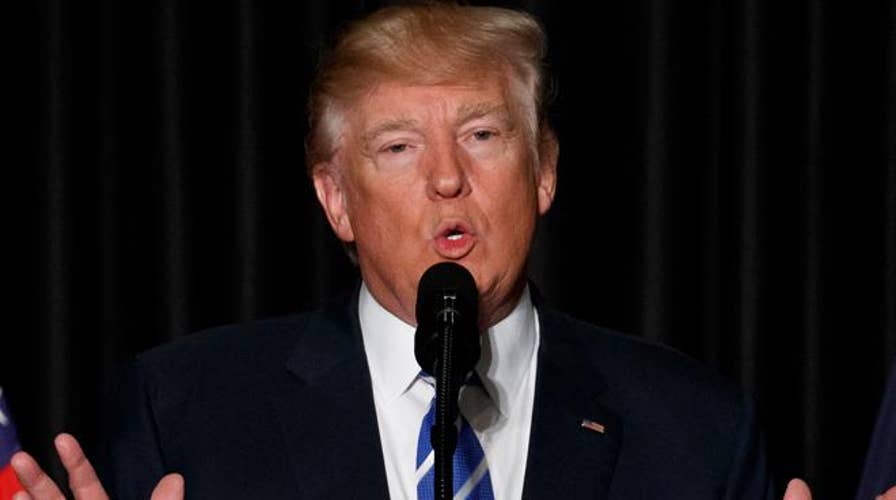Several Trump nominees still awaiting Senate confirmation
Strategy Room: Joe Lestingi and Charmaine Yoest on the slow progress being made on Capitol Hill
Even as he signs executive orders at a furious pace and plans 'yuge' changes across the federal government, President Trump is dealing with a major disadvantage: His team is not in place.
Not only has the Senate confirmed just a handful of Trump's Cabinet nominees nearly three weeks into his presidency, but hundreds of other positions remain unappointed. Part of the problem is Trump has not named most of those mid-level nominees; and part, as Trump complained Tuesday night, is Senate Democrats' “obstruction” of his Cabinet picks.
But one thing is clear: this year's Cabinet confirmation process is one of the slowest in history.
As of Wednesday, Trump was still waiting on confirmation for 10 of his 15 Cabinet nominees. By this time in 2001, then-President George W. Bush had his entire Cabinet confirmed. Then-President Barack Obama was just three short of a full Cabinet on Feb. 8, 2009.
Senate Republican leaders asserted this week that -- based on numbers provided by the Partnership for Public Service, Plum Book, and Congress.gov -- Trump has the fewest Cabinet secretaries confirmed at this point in the presidency of any incoming president since George Washington.
While Trump is pressing ahead with his agenda on immigration, security and other issues, the slow pace of confirmations underscores the struggle his administration will continue to face in getting things done.
"It is a disgrace that my full Cabinet is still not in place, the longest such delay in the history of our country. Obstruction by Democrats!" Trump tweeted overnight, as the Senate prepared to vote on his nomination of Sen. Jeff Sessions, R-Ala., for attorney general.
Trump is right that his Cabinet confirmation is facing historic delays. But the president also is expected to fill nearly 1,000 agency positions that require Senate confirmation.
CEO of the Partnership for Public Service Max Stier put the onus on Trump to put those nominations forward, telling Fox News “it begins with the executive.”
“Anyone may have reasonable complaints about Senate processes, but until the names are presented to the Senate, the ball is not in their court,” Stier explained. “The tendency is to compare to Obama or Bush or other past practice, but I don’t think any president has done this right.”
By this time in 2009, then-President Barack Obama had 24 nominees confirmed, including Cabinet and other positions. Trump has a total of seven in place, most of them Cabinet-level officials.
Stier told Fox News the next step for the Trump administration should be naming deputy secretaries for each agency. These officials are critical, he explained, as they play the role of "chief operating officers" throughout the government.
"It's critical they get put in place early enough to make these organizations run better and create good rhythm with the No. 1's,” Stier said. “If you think about this from the perspective of running an important organization or business, the idea that it could take over a year to fill key leadership spots is ridiculous.”
Yet in naming these deputy posts, it seems Trump so far is on track with his predecessors. As of Wednesday, Trump has named three: deputy secretaries of Commerce and Homeland Security, and a deputy attorney general for the Justice Department. Obama also had named three deputies at this point.
“Deputy secretaries are more important than Cabinet-level positions and they take a long time to fill,” said UC Berkeley Law Professor Anne Joseph O’Connell, who tracks presidential appointees. “You can have a secretary without government experience, but if they are paired with a deputy who understands laws that apply to government and not corporations, it works well—It’s a counter-balancing of expertise.”
O’Connell said Trump’s Cabinet nominees, assuming they’re confirmed, have relatively little government experience.
“We have an initial Cabinet with very little government experience, so you really need the deputies to get these agencies up and running,” O’Connell said.
But O’Connell noted the delay for the nominees Trump has named could be, in part, due to former Senate Majority Leader Harry Reid’s 2013 filibuster overhaul. Those changes ostensibly made it easier for a new president to confirm nominees, but also made it easier for the minority to drag out the process.
“In terms of filling the initial Cabinet, President Trump is the first under these new rules,” O’Connell said.
O’Connell noted some of Trump’s agency appointees also have not finished bipartisan vetting through the Office of Government Ethics.
“The White House usually does much of its own vetting, but this administration is doing far too little and that’s contributing to the delay.”
Partisan tensions, though, also are running high.
On Tuesday, Senate Minority Leader Chuck Schumer, D-N.Y., said that Trump had nominated “about the worst Cabinet” he had ever seen. Democrats can do little at this stage to block his nominees, however, and a series of votes is scheduled over the next week.
Obama’s full Cabinet was confirmed at the end of April 2009. But O’Connell thinks there is good news to come for Trump: “I predict President Trump will have his full Cabinet before President Obama.”






















